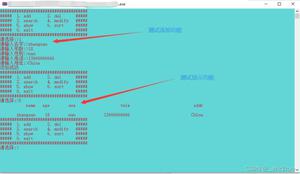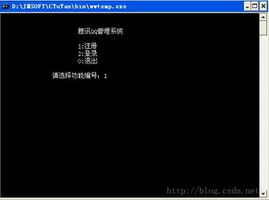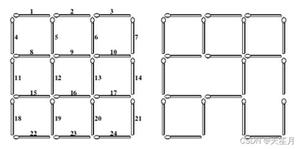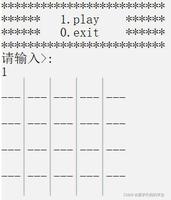C语言实现简单电子通讯录
本文实例为大家分享了C语言实现电子通讯录的具体代码,供大家参考,具体内容如下
制作一个电子通讯录,通过该通讯录能录入好友ID号、姓名(英文)、手
机号码,家庭住址,公司电话。**
原理:分成5个模块,将模块功能实现写入头文件中。主函数部分代码:
显示函数部分,在Markdown里对不齐,意思就这样,将就一下=。=
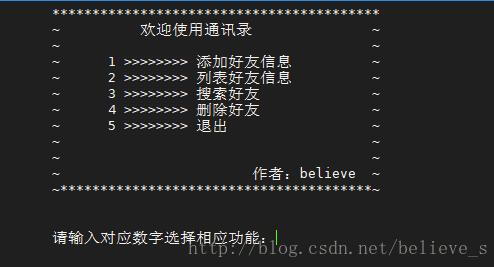
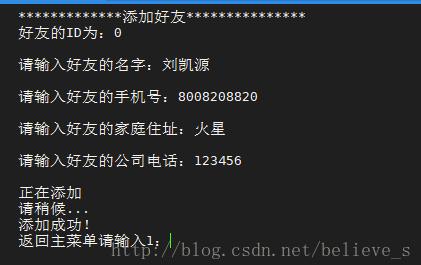
/*******************************************************************
需求:制作一个电子通讯录,通过该通讯录能录入好友ID号、姓名(英文)、手
机号码,家庭住址,公司电话。
模块:
主界面:主要显示软件功能,A)添加好友信息 B)列表好友信息。(包含排序
功能) C)搜索好友 D)删除好友
A)用户输入INSERT命令后,让用户输入好友信息。添加成功或失败都需提示
B)用户输入DISPLAY命令后,好友信息升序排列
C)用户输入SEARCH命令后,让用户输入将要搜索好友姓名查询。如果未搜索
到请友好提示。如果搜索到,显示处该好友信息
D)用户输入DELETE命令后,让用户输入将要删除好友姓名删除,如果存在同
名的多个好友,则列表出,所有同名的好友信息,让用户通过输入ID号删除
提示用户删除成功。
**********************************************************************/
#include "head.h"
int main ()
{
int Function;
int i = 0;
char Name[N];
int cho;
PNode head_node = (PNode) malloc(sizeof(Node)/sizeof(char));
if (NULL == head_node)
{
return MALLOC_ERROR;
}
head_node->next = NULL;
while (1)
{
Interface_Display ();
scanf ("%d", &Function);
switch (Function) // 功能选择
{
case 1: // 添加好友
{
Function = 0;
Add_Friend (head_node, i++);
int j;
printf ("\t正在添加\n");
printf ("\t请稍候");
fflush (stdout); // 强制刷新缓存,输出显示
for (j = 0; j < 3; j++)
{
sleep (1); // Linux 使用sleep,参数为秒
printf (".");
fflush (stdout); // 强制刷新缓存,输出显示
}
printf ("\n");
printf ("\t添加成功!\n");
printf ("\t返回主菜单请输入1:");
scanf ("%d", &cho);
if (1 == cho)
{
break;
}
else
{
printf ("\t对不起!您的输入有误!请重新输入:");
scanf ("%d", &cho);
break;
}
break;
}
case 2: // 显示好友信息
{
system ("clear");
printf ("\t*********好友信息********\n");
printf ("\n");
Friend_Information (head_node);
Function = 0;
printf ("\t返回主菜单请输入1:");
scanf ("%d", &cho);
if (1 == cho)
{
break;
}
else
{
printf ("\t对不起!您的输入有误!请重新输入:");
scanf ("%d", &cho);
break;
}
break;
}
case 3: // 查找好友
{
system ("clear");
printf ("\t*************查找好友*************\n");
printf ("\t请输入您要查找的好友姓名:");
scanf ("%s", Name);
printf ("\n");
int j;
printf ("\t正在查找\n");
printf ("\t请稍候");
fflush (stdout); // 强制刷新缓存,输出显示
for (j = 0; j < 3; j++)
{
sleep (1); // Linux 使用sleep,参数为秒
printf (".");
fflush (stdout); // 强制刷新缓存,输出显示
}
printf ("\n");
Search_Friend (head_node, Name);
printf ("\t返回主菜单请输入1:");
scanf ("%d", &cho);
if (1 == cho)
{
break;
}
else
{
printf ("\t对不起!您的输入有误!请重新输入:");
scanf ("%d", &cho);
break;
}
break;
}
case 4: //删除好友
{
system ("clear");
printf ("\t*************删除好友*************\n");
printf ("\t请输入要删除好友的姓名:");
scanf ("%s", Name);
printf ("\n");
Delete_Friend (head_node, Name);
printf ("\t返回主菜单请输入1:");
scanf ("%d", &cho);
if (1 == cho)
{
break;
}
else
{
printf ("\t对不起!您的输入有误!请重新输入:");
scanf ("%d", &cho);
break;
}
break;
}
case 5: //退出通讯录
{
Function = 0;
system ("clear");
exit (0);
}
default: //输入有误
{
Function = 0;
printf ("\t对不起!您的输入有误!请重新输入:");
scanf ("%d", &Function);
break;
}
}
}
return 0;
}
head.h部分:
#ifndef HEAD_H_
#define HEAD_H_
#include <stdlib.h>
#include <stdio.h>
#include <unistd.h> // sleep函数头文件
#define uint unsigned int
#define OK 0
#define ERROR -1
#define MALLOC_ERROR -2
#define N 20
typedef int ElementType;
typedef struct node
{
ElementType ID; // ID号
char Name [N]; // 姓名
char Mobile_Phone [N]; // 手机号码
char Home_Address [N]; // 家庭住址
char Company_Tell [N]; // 公司电话
struct node* next; // 节点指针
}Node;
typedef Node* PNode; //重命名节点指针类型
//显示操作界面
int Interface_Display ();
//添加好友信息 (尾插法)
int Add_Friend (PNode head, ElementType num);
//显示所有好友信息
int Friend_Information (PNode head);
//查找好友
int Search_Friend (PNode head, char* Name);
//删除好友
void Delete_Friend (PNode head, char* Name);
#endif
head.c的代码:
#include "head.h"
//显示操作界面
int Interface_Display ()
{
system ("clear");
printf ("\t************************************** \n");
printf ("\t~ 欢迎使用通讯录 ~\n");
printf ("\t~ ~\n");
printf ("\t~ 1 >>>>>>>> 添加好友信息 ~\n");
printf ("\t~ 2 >>>>>>>> 列表好友信息 ~\n");
printf ("\t~ 3 >>>>>>>> 搜索好友 ~\n");
printf ("\t~ 4 >>>>>>>> 删除好友 ~\n");
printf ("\t~ 5 >>>>>>>> 退出 ~\n");
printf ("\t~ ~\n");
printf ("\t~ ~\n");
printf ("\t~ 作者:believe ~\n");
printf ("\t~*************************************~\n");
printf (" \n");
printf (" \n");
printf ("\t请输入对应数字选择相应功能:");
}
//添加好友信息 (尾插法)
int Add_Friend (PNode head, ElementType num)
{
if (NULL == head)
{
return ERROR;
}
//创建一个新的结点
PNode p = (PNode) malloc(sizeof(Node)/sizeof(char));
if (NULL == p)
{
return MALLOC_ERROR;
}
//将新数据赋给新结点
system("clear");
printf ("\t*************添加好友***************\n");
p->ID = num;
printf ("\t好友的ID为:%d\n", p->ID);
printf ("\n");
printf ("\t请输入好友的名字:");
scanf ("%s", p->Name);
printf ("\n");
printf ("\t请输入好友的手机号:");
scanf ("%s", p->Mobile_Phone);
printf ("\n");
printf ("\t请输入好友的家庭住址:");
scanf ("%s", p->Home_Address);
printf ("\n");
printf ("\t请输入好友的公司电话:");
scanf ("%s", p->Company_Tell);
printf ("\n");
p->next = NULL;
//找到最后一个结点
PNode Ptmp; //将头结点地址给临时指针Ptmp
Ptmp = head;
while (Ptmp->next)
{
Ptmp = Ptmp->next;
}
Ptmp->next = p;
return OK;
}
//显示所有好友信息
int Friend_Information (PNode head)
{
if (NULL == head)
{
return ERROR;
}
PNode p = head->next;
printf ("\tID\t姓名\t\t手机号\t\t住址\t\t\t公司电话\n");
while (p)
{
printf ("\t%d\t%s\t\t%s\t\t%s\t\t\t%s\n", p->ID,
p->Name, p->Mobile_Phone, p->Home_Address,
p->Company_Tell);
p = p->next;
}
putchar('\n');
return OK;
}
//查找好友
int Search_Friend (PNode head, char* Name) //通过名字查找好友
{
PNode p = head;
PNode q = NULL;
if ((NULL != p) && NULL != (p->next))
{
while (p->next)
{
q = p->next;
if ((NULL != q) && 0 == (strcmp(q->Name, Name)))
{
printf ("\t好友信息: \n\tID:%d\n\t姓名: %s\n\t手机号码: %s\n\t家庭地址:%s\n\t公司电话: %s\n", q->ID, q->Name, q->Mobile_Phone, q->Home_Address, q->Company_Tell);
}
else
{
printf ("\t对不起,您的通讯录没有该好友!\n");
}
p = p->next;
}
}
/* 另一种做法
if (NULL == head)
{
return ERROR;
}
PNode p;
int flag = 1;
for (p = head->next; p != NULL; p = p->next)
{
if (0 == strcmp(p->Name, Name))
{
flag = 0;
printf ("\t好友信息:\n\tID: %d\n\t姓名: %s\n\t手机号码: %s\n\t家庭地址: %s\n\t公司电话: %s\n", p->ID, p->Name, p->Mobile_Phone, p->Home_Address, p->Company_Tell);
}
}
fi (flag)
{
printf ("\t对不起,您的通讯录没有该好友!\n");
}
putchar('\n');
*/
return OK;
}
//删除好友
void Delete_Friend (PNode head, char* Name)
{
PNode p = head;
PNode q = NULL;
while (NULL != p && NULL != (p->next))
{
q = p->next;
if (NULL != q && 0 == strcmp(q->Name, Name))
{
p->next = q->next;
free(q);
int j;
printf ("\t正在删除\n");
printf ("\t请稍候");
fflush (stdout); //强制刷新缓存,输出显示
for (j = 0; j < 3; j++)
{
sleep (1); //linux使用sleep,参数为秒
printf (".");
fflush(stdout); //强制刷新缓存,输出显示
}
printf ("\n");
printf ("\t该好友已成功删除!\n");
}
else if (NULL == q->next && 0 != strcmp(q->Name, Name))
{
printf ("\t您的通讯录没有该好友!\n");
}
p = p->next;
}
}
以上就是本文的全部内容,希望对大家的学习有所帮助,也希望大家多多支持。
以上是 C语言实现简单电子通讯录 的全部内容, 来源链接: utcz.com/p/245308.html


